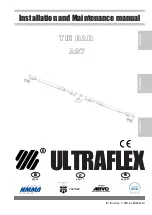
1
2
G003409
Figure 27
1.
Enter a trap straight into
the long dimension in a
level area.
2.
Exit a trap at a right angle
in a level area.
Enter the trap straight into the long dimension, where the
bank is the least steep. Drive through the center of the trap
almost to the end, turn to either direction as sharp as you can,
and come back right next to the first pass. Spiral outward as
shown in
, and leave the trap at a right angle in a
level area.
Leave steep, short banks and small pockets for touch-up with
a hand rake.
Entering and Leaving the Trap
When entering the trap, do not lower the rake until it is
over the sand. This avoids cutting the turf or dragging grass
clippings or other debris into the trap. Lower the rake while
the machine is moving.
When leaving the trap, start raising the rake when the front
wheel leaves the trap. As the machine moves out, the rake will
be lifting and will not drag sand out onto the grass.
Through experience and practice, the operator will soon
understand the required timing for entering and leaving the
trap properly.
Breaking in the Machine
New engines take time to develop full power. Drive systems
have more friction when they are new, placing additional load
on the engine.
Allow the first 8 hours of operating time for the break-in
period.
Since the first hours of operation are critical to future
dependability of the machine, monitor the functions and
performance closely so that you can notice and correct minor
difficulties, which could lead to major problems. Inspect the
machine frequently during the break-in period, for signs of oil
leakage, loose fasteners, or any other malfunction.
Pushing or Towing the
Machine
WARNING
Hands may become entangled in the rotating drive
components below the engine deck, which could
result in serious injury.
Stop the engine, remove the key, and allow
all moving parts to stop before accessing the
bypass-valve levers.
WARNING
The engine and hydrostatic transmissions can
become very hot and cause severe burns.
Allow the engine and hydrostatic transmissions to
cool completely before accessing the bypass-valve
levers.
Important:
Do not tow the machine for long distances
or at high speeds. Doing so could damage the machine.
You can tow the machine slowly from the grooming
surface to the on-site trailer.
The bypass-valve levers are located on the top of each
hydrostatic transmission.
Important:
Make sure that the bypass-valve levers are in
the fully forward position when operating the machine,
or severe damage to the hydraulic system can occur.
1.
Stop the machine on a level surface and turn the
ignition key to the Off position.
2.
Move the levers to the neutral-locked position, set the
parking brake, and remove the key.
3.
From underneath the machine, rotate the bypass-valve
levers (
and
) so that they point
inward, toward the center of the machine (
and release the parking brake; refer to
Parking Brake (page 25)
.
Note:
This allows the hydraulic fluid to bypass the
pumps, enabling the wheels to turn freely.
29
Содержание Sand Pro 2040Z
Страница 58: ...Notes 58...















































